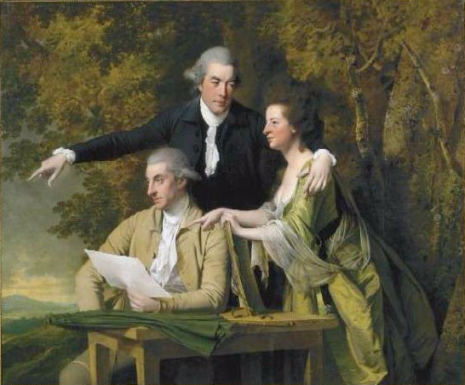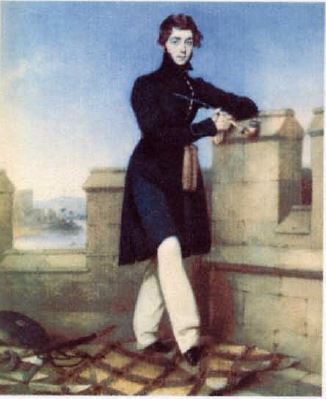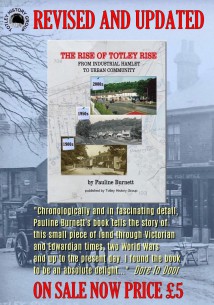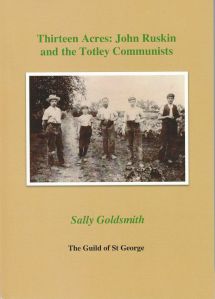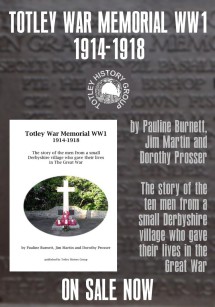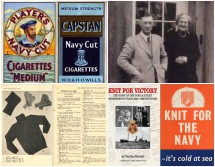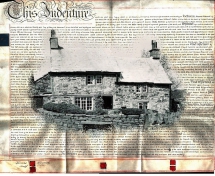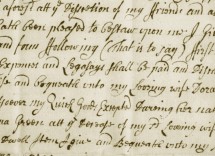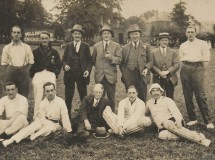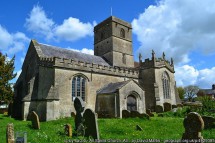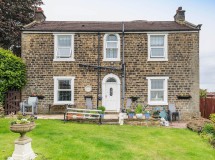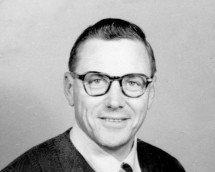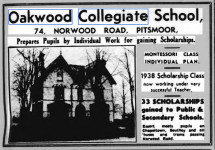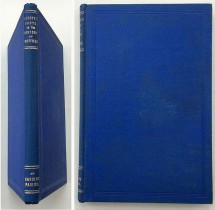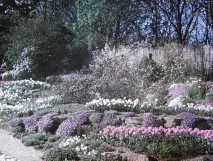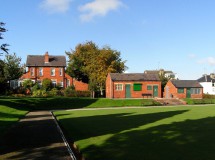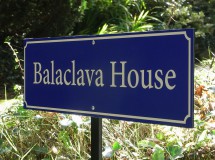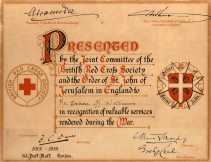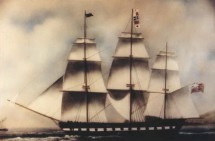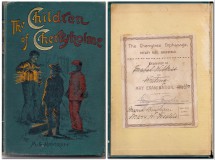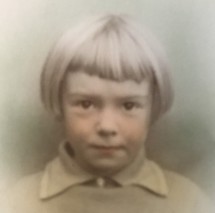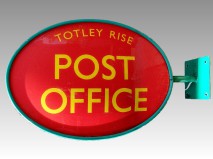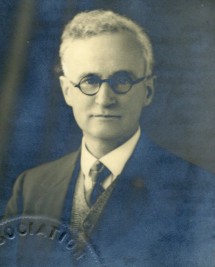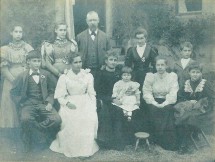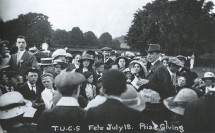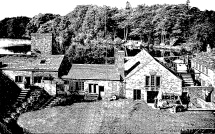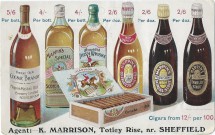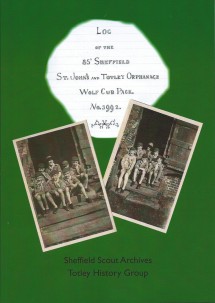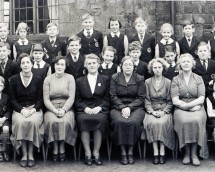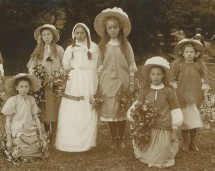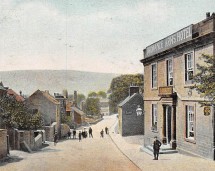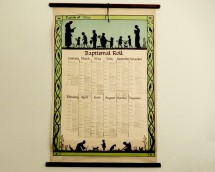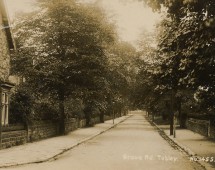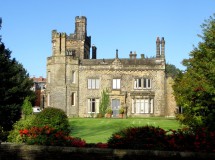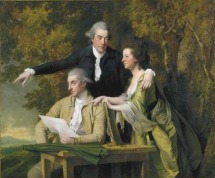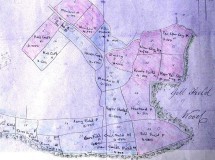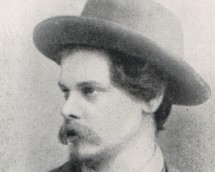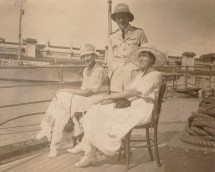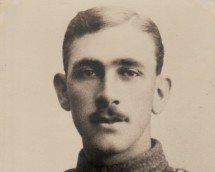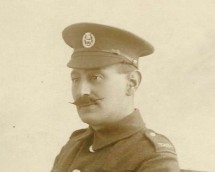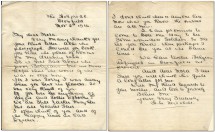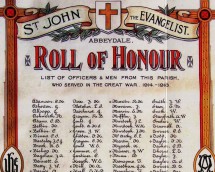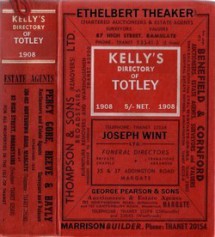The Coke Family & Totley Hall Estate
by Josie Dunsmore
Introduction
At the end of the 18th century the Totley Hall Estate roughly consisted of three “parts” or “moieties” – the Hall, two old farms between Totley Hall and Gillfield Wood, which amalgamated into one in
1808 and three farms in Dore. The early history of the Estate is very complex and is still in the process of being untangled. In the 16th and 17th centuries wealthy gentry landowners and yeoman
farmers bought up “parcels” (i.e. blocks) of land scattered throughout different parishes. Some of these parcels were passed down through the generations within one family, whilst others were sold
off to finance their owners consolidating and enlarging of their central estates. To make matters more complicated some of the parcels and individual fields were owned by several different people who
willed these on in various directions.
Documents relating to the early history are few and far between, and take the form mostly of Wills, Deeds and odd references. However, by the 18th and 19th centuries more documentation, maps and
accounts are available to give a more complete picture of the Totley Estate’s history.
In Matlock Records Library there is a biography of the “Cokes of Trusley” and enough documentation to build up a history of the family that owned Totley Hall Estate for nearly a century. As there are
four “D’Ewes Cokes” involved, to avoid confusion I will refer to them as Rev. D’Ewes, D’Ewes Coke of Poole, D’Ewes Coke and F. L. D’Ewes.
These owners of the Totley Estate were from Pinxton near Alfreton in Nottinghamshire. However they had an early connection with Totley. According to notes on Totley Hall in The Old Halls, Manors and Families of Derbyshire a deed dated 1402 shows that the Manor of Totley had been in the hands of the Milnes of Ashlockton in Nottinghamshire, who were related to the Cokes of Trusley. Four hundred years later descendants from a branch of this family came back to Totley. (See family tree and Coke of Trusley arms.)
1791–1811 Reverend D’Ewes Coke
The first member of the Coke family to inherit the Totley Estate was Reverend D’Ewes Coke, who was born in 1747. His father died when he was 11 years old, and his father’s friends, Mr Lillyman, a lawyer of Brookhill Hall, Pinxton, and his wife, became his guardians. In 1772 D’Ewes married Hannah, the daughter and wealthy heiress of George Heywood of Brimington Hall, Chesterfield. Hannah’s mother had died when she was small and she had been rather spoilt by her father. Fortunately George Heywood seems to have taken a liking to his son-in-law and purchased the Presentation of the Rectorship of Pinxton and South Normanton for him. Rev. D’Ewes and Hannah had three sons D’Ewes, William and John and a daughter Hannah.
Rev. D’Ewes inherited Brookhill Hall from Mrs Lillyman in 1784 as well as Werneth in Cheshire. By his marriage he inherited Brimington Hall on the death in 1784 of Hannah’s father, who favoured his
son-in-law over his own son. George Heywood Junior was passed over as heir, and got only an annuity of £100 because he had displeased his father by proposing to marry their servant, Jane Siddall.
Estates in Totley, Dore and Swaddale were left to Hannah by her bachelor uncle, Anthony Gallimore of Chesterfield, in 1791.
The Dore part of Hannah’s inheritance consisted of three farms – one around the Gilleyfield area and two around King’s Croft with farmhouses abutting Church Lane. The Totley part was Totley Hall and farm in the tenancy of Peter Flint. The adjacent farm was bought by Rev. D’Ewes in 1796 with a mortgage of £1000 loaned by his uncle, D’Ewes Coke of Poole, completing the Coke’s Dore and Totley Estate and making them one of the largest landowners in both villages. Hannah’s land was administered by her husband.
Rev D’Ewes Coke was not a healthy man. He was deaf in one ear due to a blow to the head from a teacher, and he suffered from asthma. However, he was thought to be a clever artist who enjoyed etching on copper. Sadly while doing this he had an accident and lost his sight. He continued in his role as Rector, learning the Services by heart, and was remembered fondly as a good man by many after his death in Bath on 12 April 1811. He was buried at Pinxton in his own Church, where there is a memorial.
Rev. D’Ewes seldom visited Totley during the twenty years he held the estate – relying on agents and tenant farmers to maintain the land while he took their rental money, though he was a Trustee of the earliest school at Dore. The member of the family who wrote the biography “Coke of Trusley” said that Totley and Dore were “desirable sporting properties, but little visited by the family”. The farm tenants were left to manage as best they could. (See the tale of Peter Flint to see what happened in the absence of his landlords.) In 1809 his son John wrote on behalf of his father to Fairbanks Surveyors and acting agents. He said “his father did not chose to go to the expense of a survey at that time but wanted Fairbanks to put as high a value on Totley as you suppose circumstances will allow”. No wonder the tenants struggled to pay their rents when harvests were poor.
1811–1818 Hannah Coke
After Rev. D’Ewes Coke died the Totley and Dore Estates reverted to his wife Hannah and were administered by her sons D’Ewes and John. The main family estates were inherited by eldest son D’Ewes, and
second son William inherited the small estates of Brimington and Tapton and the rental of Totley and Dore. William was a Barrister-at-Law who was knighted and became Chief Justice of Ceylon. He spent
a number of years abroad and died unmarried on 1 September 1818, relatively young aged 43 at Trincomalee, Ceylon (now Sri Lanka). Three weeks later his mother Hannah Coke also died, leaving her lands
in Dore and Totley to her eldest son D’Ewes.
1818–1856 D’Ewes Coke Esq of Brookhill Hall, Notts.
D’Ewes Coke was born on 22 December 1774. He was a Barrister-at-Law, the Recorder for both Newark and Grantham Corporation from 1805, and Land Agent to Duke of Rutland from 1811 to 1839. On 2
November 1797 he married Harriet, daughter of Thomas Wright, Esq. of Mapperley Hall, Notts, and they had ten children, five boys and five girls.
In 1800 D’Ewes Coke bought Langton Hall Farm near Pinxton from his father with part of his wife’s fortune. It was in a ruinous condition but D’Ewes Coke renovated it as a home for his young wife and later his growing family.
Author and personal friend Spencer T Hall in his Biographical Sketches of Remarkable People described D’Ewes Coke as being tall, open, intelligent, a severe critic and faithful friend to many, and reservedly proud on occasions. John Henry, 5th Duke of Rutland, was also a friend of his agent D’Ewes Coke and spoke highly of him. D’Ewes Coke became deaf and retired early from the Law, and he concentrated on his other roles, especially as landowner and agent. Hall says “He had a peculiar theory of tenure and rental, which was that the first persons having a right to live on the produce of the land are they who cultivated; next, the poor who cannot help themselves, the landlords coming last and taking what can be justly spared.” (Coke of Trusley, p.104). One wonders if he didn’t deal too harshly with his Totley tenant, Peter Flint, whom he sacked when he struggled to make a go of it at Totley Hall Farm.
When people die one is often apt to overlook their faults and failings and see them through rose-coloured spectacles. Having read a number of D’Ewes Coke’s business letters I find it hard to accept the above statement. On the contrary he sought to extract every penny he could from the tenants of both himself and his employer, the Duke of Rutland. For example, when he first became the Duke’s land agent, in a letter to Fairbanks Sheffield Surveyors about valuing the land, he wrote “I intend to put the whole on full rent”. In a second letter he commented “The Duke is at present far from rich. I must therefore have it done in the cheapest possible way to be well done.” It is hardly surprising that by 1818 the tenants of both Totley and Dore were begging for a rent reduction, especially as they had all suffered from a poor harvest the previous year. On this occasion D’Ewes Coke responded to his tenants’ appeal and made a small reduction in their rent.
However S. T. Hall goes on to say of D’Ewes Coke that “waste of any kind was decidedly painful to him, from waste land to waste paper whether belonging to himself or others”. This would account for him not tolerating his Totley farm being allowed to go to rack and ruin. However he had a reputation for being a good landlord keeping cottages, drainage and even smoking chimneys in good repair.
Despite all his best efforts it appears that the Totley Estate was run at a loss. Writing to his eldest son F L D’Ewes in Stockholm in April 1830, he says that he has had to have two small timber sales on his Brimington and Langton Estates “… or I could not have paid my way for Totley. This however is now over till it becomes your turn. I believe this has been a grateful little place and has done more for me than I could have conceived considering the wretched state in which my Father (i.e. Rev. D’Ewes Coke) left it – so it will be for you if you have the sense to keep it. With all I have done the state of my affairs is very embarrassing to me after paying away all the rents that come in and having no demands of sort I still have £470 of tradesmen’s bills of which £230 are 3 years old.” Even ten years later the Estate still wasn’t thriving, despite having land from the Commons added in both Dore and Totley.
D’Ewes Coke didn’t like show or parade, but spent liberally on building, endowing and subscribing to schools and libraries. For example, a new school was built at Dore in 1821, and plans were made to build a school at Totley around that time. This was to be built on a four acre site enclosed from the Commons at Moss Road. The land had already been purchased for the purpose in 1720 by a bequest in from Rev Robert Turie, assistant Vicar of Sheffield. It was intended that money for the school was to be raised by subscription, but five years later nothing had happened. This evidently did not suit the go-ahead business-like D’Ewes Coke, who had had enough of waiting and decided to build the school on his own land in Totley Hall Lane and enlist the subscribers himself. The idea was to raise £150 by the generous giving of local landowners. Letters show that he had to chivvy some of them along to get them to pay up. In the end the subscribers paid but D’Ewes Coke himself gave the land, building and furnishings for the school, which opened in 1827 and included a schoolroom and house for the teacher, which still exists on Totley Hall Lane.
One senses that D’Ewes Coke was a real dynamic go-getter. Letters show he was always out and about around his estates, keeping an eye on his property, as well as staying at Castlehill, Bakewell and Longshaw when on business for the Duke of Rutland. Besides being involved with his various Estates he found time to be involved in the local communities, serving as Chairman of the Parish Council between 1835 and 1845 when Totley was being mapped and surveyed by Sanderson of Mansfield (close by Brookhill, Coke’s main seat) for the Tythe Award in 1840, and again through the difficulties and pitfalls of the Inclosure of the Commons in 1841. He had also been involved in the later stages of the lengthy Dore Inclosure 1809 – 1821.
D’Ewes Coke’s skills as a lawyer must have been useful in assisting to engineer the Inclosure of Totley Commons. In 1834 the Parochial Meeting comprising himself and the other four largest landowners discussed a letter from the agent of Lord Middleton, Lord of Totley Manor (i.e. Township not Manor House). Lord Middleton was displeased that “Strangers” were getting stone off the Commons. In this case the outsiders were men repairing the Turnpike Road. The Totley landowners devised a clever reply, saying that though they regretted the damage caused, the Highways Laws prevented them responding, as getting stone to mend roads was legal. They “respectfully submitted to his Lordship that the only method to prevent destruction of the best part of the Commons by Strangers getting stone there is an Inclosure in which this meeting beg to state they will at all times be ready to concur”. Of course they would, the crafty chaps! They would be the ones who would benefit most by getting more land by Inclosure. Lord Middleton agreed to the Inclosure of the Commons on certain terms, namely (i) that he reserved coal and ironstone for himself; (ii) to keep 35 – 40 acres of the Commons lying conveniently for the cottages; and (iii) to be free of any expense in obtaining the Inclosure Act, surveying or fencing his allotment.
D’Ewes Coke seems to have regarded his Totley property as something of a retreat, and spent time and money prettying up the woodland. Soon after retiring as the Duke of Rutland’s agent he obviously considered selling at one point as in a letter a relative wrote “It would be a great pity to give up Totley for you seem to like it and from all accounts it is a much more healthy situation than Brookhill, which never suits you for long.” Brookhill Hall was among the Nottinghamshire coal mines.
Alfred Wolstenholme of Woodseats published a letter in the Daily Telegraph in 1895 remembering Gillfield Wood where D’Ewes Coke “allowed public access, but made some miles of serpentine cross and other walks in the wood, built log cabins and rustic seats, and made it a very pleasant place”. D’Ewes Coke also enjoyed the old 17th century Totley Hall, and appears to have kept it in the original décor. The rambling old house is described in detail by J. D. Leader in 1875 who visited the Hall with members of Sheffield Archaeological Society when it was tenanted by Frederick Hunt. After D’Ewes Coke’s death the House was presumably left as it was – stuffed with antiques and curios collected from all over the neighbourhood. The Hall with its uneven floors had walls hung with pikes, guns, bows and fishing tackle. There was a fine old dining table accompanied by oak chairs of as many patterns as could be found in an old curiosity shop. Leader found the House to be not too large but roomy, comfortable and picturesque. It certainly seemed to be much-loved by D’Ewes Coke but, despite his best efforts, the estate was running at a loss.
D’Ewes Coke appears to have taken his relative’s advice as he hung on to his Totley and Dore estate until he died on 22 October 1856, and the Totley Estate passed on to his eldest son F. L. D’Ewes..
1856–1873 Francis Lillyman D’Ewes Coke
(Known as “F. L. D’Ewes”)
Francis Lillyman D’Ewes Coke was born in 1804. He was named Lillyman after his grandfather’s guardians, and educated at Shrewsbury School and Christchurch College Oxford.
Strangely there are no biographical notes of him in Coke of Trusley. He is listed as D’Ewes Coke’s eldest child, but his name is omitted from the family tree in the above volume. The Coke’s biographer mentions that in 1873 (the year of Francis’s death) William Sacheverall inherited “from his elder brother D’Ewes”, so we know he owned Totley Hall after the death of his father.
The only information I’ve been able to uncover about the mystery of F. L. D’Ewes is in the family letters. After leaving Oxford he visited several places around Britain, then visited Paris. This appears to have given him a thirst for travel as from 1829 to 1835 he spent several weeks a year staying in hotels in major cities in various parts of Europe. For example in 1830 he visited Stockholm, Bergen and Christiana in Norway as well as St Petersberg and Gotha. He was funded by his Father with whom he carried on an affectionate correspondence. Occasionally his Father mentioned the estate at Totley which F. L. D’Ewes was expected to inherit. In 1834 F. L. D’Ewes appears to have lived at La Grande Carrée Hotel, S Simplonica from September to December. A drawing of this hotel and his passport survive in the Matlock family archive.
Then in June 1835, six weeks after going to France, F. L. D’Ewes brother-in-law George Robinson (husband of sister Sophy), who was holidaying in Brighton with his family, by chance bumped into F. L. D’Ewes, who was looking overweight, ill and dejected – and was penniless. In three letters to his father-in-law D’Ewes, George describes in detail what happened over the next ten days. The story reads like a Victorian melodrama. It seems that something, possibly a broken romance, had occurred in France that had caused F. L. D’Ewes to have a complete mental and physical breakdown. During the ensuing week he was evicted from his hotel, had the police searching for him and threatened suicide, before being located and taken under the wing of the family. He walked around their lodgings all night opening drawers and cupboards, gorging his food and drifting off into trances and he had lost his short term memory. After some days he suddenly hired a post chaise and rushed off home to see his father. Whether he ever recovered from his breakdown is a mystery, but there are no further letters between F. L. D’Ewes and his father and no records of him in the Coke papers being involved with Totley. As his name does not appear much, if at all, in Totley historical documents, it appears that he was another absentee landowner who had tenant farmers running the Totley Estate and an agent to collect the rent.
There were two Coke tenant farmers at Totley Hall Estate during the time F. L. D’Ewes was owner. Charles Alsop was Farm Bailiff from 1857 to 1860. Then from 1861 Frederick Hunt, Esq, who lived at Totley Hall, was tenant for almost 20 years. He was the owner of clay sheds and works in Deep Hollow. He appears to have treated the Estate like his own, using Gillfield Wood for private sport and putting up “Trespassers will be Prosecuted” notices, thus closing off what had been for centuries considered rights of way.
F. L. D’Ewes Coke died childless and unmarried on 19 December 1873, and the Totley Estate passed down to his brother William S. Coke.
1873–1881 William Sacheverall Coke J.P.
Born on 31 August 1805 William Sacheverall Coke was the second son of D’Ewes Coke Esq. His middle name was an old Coke family name.
At the age of 19 he obtained a commission in the 39th Regiment which was granted at the request of the Duke of Rutland, his father’s friend and employer. He rose to the rank of Colonel, but in 1830 he left the army and spent some time at the Cape of Good Hope. He returned there in 1835 when he sailed from England in a small yacht and became the first person to reach the Cape without touching land – an amazing feat. William liked the Cape so much that he sold his yacht and bought land at Elsey’s Kraal outside Capetown. There he met his first wife Sarah Kitt, daughter of John Deane Esq of the Cape of Good Hope, and they married in 1837 before returning to England to live at Langton Hall, one of the Coke Family properties. Here Sarah bore 17 children and (unsurprisingly) died in 1870. Six months after her death, William, by now a J.P., remarried Susan Annie, daughter of R. Miller Esq. (deceased) of Seaton, Devon. Together they had three more children, making William the father of twenty.
On the death of his brother F. L. D’Ewes in 1873, William S. succeeded to Brookhill, Totley and Dore and other properties. William S. appears to have had a similar character to his father – orderly
and businesslike. He adopted a policy of selling off the smaller family estates to have funding to consolidate Brookhill. He began in 1874 by selling Brimington and also Dore, which was bought by the
Duke of Rutland.
At this time he also sold off timber and coppice wood from Gillfield Wood and sold the small Trickett Wood to Thomas Andrew, carter and farmer. Frederick Hunt, Esq continued as his tenant farmer at Totley Hall until 1880.
On 25 Mar 1881, after 90 years of Coke family ownership William S. Coke sold Totley Hall Estate on a 60 year lease at a rent of £145 p.a. including sporting rights to John Unwin Wing, who had previously rented Brinkburn Grange. Mr Wing was a self-made man who was an accountant, investor and debt collector, and who had written a book on double entry book- keeping. He immediately set about extending and “modernizing” the old 17th century Totley Hall, replacing small mullion windows with large Victorian bays. He added a new wing with an internal balcony leading to new bedrooms with a billiard room below. John, his wife Jemima and four children moved into the incompleted Hall in September 1881. However, before the alterations were finished, he got into financial difficulties and borrowed £5,500 from the Union Bank using the Hall and Estate as surety. Then on 12 May 1882, only a few months after moving into Totley Hall, John Unwin Wing was arrested for embezzlement and fraud, and, bail being denied, was sent to Wakefield Jail. Within days his creditors put the Hall and contents of the house, farm and outbuildings up for sale to recoup their loan without waiting to see if Wing was guilty or not.
The Hall was next bought by William Kent Marples of Totley Grove for £2,250 and the annual rent on the 60 year lease. By the time he moved into the Hall William Marples and his wife Jane had five children aged between 2 and 12 years, four sons and a daughter. Mr Marples was employed in his family’s business as an Edge Tool Merchant and Manufacturer in Hibernia Works in Westfield Terrace, Sheffield. He was universally respected, kindly and a supporter of good causes, churches and chapels, as well as being active and interested in local affairs and being a keen and knowledgeable botanist. His special interest was in Totley Orphanage “Cherrytree” and called the children his “other family”. He organised treats and country outings for them and often visited the Home.
As the alterations begun by John Wing were incomplete Mr Marples employed an architect, J. D. Webster, to continue with the work, which is why the central gable of the present Hall is embellished with a small shield bearing W. K. Marples’ monogram and the date 1883 and not John Wing’s. A total of £2000 on improvements to the buildings and driveways was said to have been spent by Mr Marples.
Although he was actively involved with the family business and served on the Sheffield Council in the Chamber of Commerce as well as being involved in local events and charities, William Marples suffered from ill health. This deteriorated so badly that he was advised by his doctor to spend the winter months in a warmer climate. Consequentially he and his wife and the two youngest children set off in late October 1883 for the Grand Iles D’Or, Hyeres, France. He was ill on the journey and then contracted a severe infection to his lungs. He sadly died on 25 November, aged only 44, just over a year after purchasing Totley Hall. Mrs Marples and her five children moved out of Totley Hall a few months after her husband’s death, and once again Totley Hall was up for sale – for the third time in four years.
On 16 February 1884 the Hall was purchased for £2,850 and the annual rental by William Pashley Milner of Meersbrook Hall for his son William Aldam Milner and his wife Sarah Elizabeth (nee Roberts). New owner William A. Milner was finally able to buy the Hall outright in 1893 from Wm S Coke for £4,500, a sum which merged and extinguished the rental term of 60 years. This transaction ended the Cokes one hundred year association with Totley Hall.
Josie Dunsmore
Updated September 2021
Search Our Website Here
September
October
November
Unless stated otherwise our meetings are held in Totley Library on the 4th Wednesday of each month at 7.30pm.
Pauline Burnett's book The Rise of Totley Rise has been revised and updated. It tells the story of this small piece of land from 1875 when there was only a rolling mill and chemical yard alongside the river a mile from Totley, through Victorian and Edwardian times, two world wars and up to the present day. It has 94 pages including a useful index and many illustrations from private collections. The book is available now from Totley Rise Post Office priced at £5, or through our website when an additional charge will be made to cover packing and postage.
A few copies are still available of Sally Goldsmith's book Thirteen Acres: John Ruskin and the Totley Communists. Totley was the site of a utopian scheme funded by art critic and social reformer John Ruskin. In 1877 he bought 13-acre St. George’s Farm so that nine Sheffield working men and their families could work the land and, to keep themselves busy, make boots and shoes. Sally tells an engaging story from our history with a quirky cast of characters including Ruskin himself, the poet and gay rights activist Edward Carpenter and Henry Swan, a cycling, vegetarian artist and Quaker. The book is available to order online from the The Guild of St. George by following this link.
A recently discovered box of WWII correspondence reveals the story of how a small group of ladies from Dore and Totley recruited knitters from the west of Sheffield and how their efforts made them the country's greatest provider of Comforts for the Minesweeping crews of the Royal Navy. The story is told in Knit For Victory, a new book from Totley History Group. Written by Pauline Burnett, it has 82 pages and many illustrations. It is on sale in local shops and via our website. Further information about the correspondence is in this inside page of our website: Dore & Totley Minesweeping Trawlers Comforts Fund.
The story is told in Totley War Memorial WW1 of the ten men from our village who gave their lives in the Great War. Written by Pauline Burnett, Jim Martin and Dorothy Prosser, a chapter is devoted to each of the soldiers with a family tree followed by as much information as could be discovered about the men and their families. There is also information about their military careers and the actions in which they lost their lives. The book has 64 pages and is illustrated throughout with photographs of the men, their families and the houses where they lived.
Totley All Saints' Church Parish Magazines for the years 1985-2006 with notices of baptisms, marriages and funerals and accounts of spiritual, educational, charitable and social matters in the village. Scanned in full, including advertisements from local traders.
In 1893 during the building of the Totley Tunnel there was an outbreak of smallpox amongst the navvies which spread to some of the local population. 17 people were buried in communal graves in Dore Churchyard, 6 from "Green Oak" (Lemont Road). The severity of the outbreak was principally caused by overcrowding and insanitary conditions in lodging houses .
Kathleen Grayson was a 39 year old housewife when WW2 broke out. She volunteered for the ARP and became an ambulance driver. During an air raid on Sheffield in July 1941, and despite her own injuries, she managed to get a seriously injured casualty to hospital. For this she was awarded a commendation from King George VI. Together with her friend Hilda Duffy, Kathleen also assembled a team of knitters to provide essential warm clothing for the men serving on the minesweepers patrolling the North Sea.
We have recently bought at auction the WW2 memorabilia of Douglas Platts whose family home was at Hillside, 98 Queen Victoria Road. After the war Douglas returned to his civilian occupation working in the family scissors manufacturing business. He lived in our area for the rest of his life.
We are very grateful to Mrs Valerie Taylor of Dore for lending us the title deeds to Lower Bents Farmhouse which is reputed to be the oldest surviving building in the area with a proven history back to 1621. We have now scanned and transcribed the deeds which could be particularly interesting to anyone with a connection to the local Fisher, Dalton and Marshall Families.
Until 1844, when Dore Christ Church parish was created, Totley township was part of Dronfield parish. We have now transcribed the burial records for former Totley residents at St. John the Baptist, Dronfield for the period 1678-1870 and at St. Swithin, Holmesfield for the period 1766-1901.
Whilst researching the history of the Dalton Family we found it useful to transcribe a number of early Wills and Inventories. These and those of many other Totley, Dore and Holmesfield people dating from between 1594 and 1856 have now been added to our website.
St. Swithin's Church, Holmesfield pre-dates Dore Christ Church and was the place where many of the people from Totley worshipped and were baptised, married and buried. Read the inscriptions on more than 750 gravestones in the churchyard including those of Mr. and Mrs. William Aldam Milner of Totley Hall, Jessie Matilda Tyzack (nee Fisher) of Avenue Farm, and Rev. J. A. Kerfoot of St. John's, Abbeydale.
Thomas Youdan was a music hall proprietor and benefactor who was living at Grove House, Totley in 1867 when he sponsored the first football knockout competition in the world for The Youdan Cup.
The words Millhouses Cricket Club can be seen in the background of team photos which are likely to date from between 1905 and the early 1920s, very probably pre-war. They were lent to us by Garth Inman who can identify his great uncle, Cecil Inman, in some of the photos and would like to know when they were taken and, if possible, the names of others present. Please take a look to see whether you can put names to any of the faces.
Josiah Hibberd was seriously injured whilst working on the construction of the Totley Tunnel in 1892. He died on 9 May 1897 at the age of 38 having apparently spent most of previous five years in hospital.
Bradway House was built around 1832 by Henry Greaves, a farmer, together with two adjacent cottages. We have traced most of the occupants of the property from these early days up to the start of World War Two.
We have transcribed the baptisms records at St. John the Evangelist, Abbeydale from when the church was consecrated in 1876 until just after the start of World War 1. The records are arranged in alphabetical order based upon the child's name and show the date of baptism, the names of the parents, their home location and occupation.
Nick Kuhn bought an original 1920s poster which had this owners' blind stamp in one corner. The stamp almost certainly refers to a house named Wigmore that was built in the late 1920s or early 1930s. The first occupiers that we can trace are John Howarth Caine, a district mineral agent for the LNER, his wife Florence Jane (nee Prince) and daughter Doris Mary. The Caine family lived at Wigmore until 1936 by which time the house would have been known simply as 12 The Quandrant.
George Griffiths died on 13 December 1888 following an explosion during the sinking of number 3 airshaft at Totley Bents. His widow Florence died shortly afterwards and his two daughters Maud and Annie were adopted separately. Whilst Annie lived the rest of her life in Yorkshire, Maud emigrated to Australia in 1923 with her husband, John Burrows, daughter Margaret and son Jack, pictured above.
George Wainwright was said to have been born in Bamford, Derbyshire in 1714. He learned the trade of linen weaving and moved to Totley after his marriage on 1744. He became an ardent follower of John Wesley who paid many visits to Sheffield and who would have passed through or close to Totley. Preaching was at first conducted out of doors and when Wesley's preachers became harassed by a mob of Totley ruffians in 1760, George offered them safety of his own home. He remained a Methodist for all of his long life, dying in Dore in 1821 at the reputed age of 107.
Oakwood School was started by Mrs Phoebe Holroyd in 1925 initially as the Firth Park Kindergarten and, by 1927, as the Firth Park Preparatory School. Phoebe was still working at the school almost fifty years later when she was well into her seventies. We would like to hear from anyone with memories of the school.
James Curtis was born at sea aboard HMS Chichester in 1790. He enlisted as a Private in the 1st Grenadier Regiment of Foot Guards in Sheffield in 1812 and served in Spain and Portugal during the Peninsular War. He later fought in France and Belgium taking part in the Battle of Waterloo. In later life James lived at the Cricket Inn where his son-in-law William Anthony was the licensed victualler. He died in Heeley in 1882 aged about 91.
Charles Paul lived in Totley in later life. He was a local historian and archaeologist who was an authority on the history of Sheffield, especially the two areas he knew best: Attercliffe and Ecclesall. His books and letters to local newspapers were published under the Latin form of his name Carolus Paulus.
Towards the end of the 19th century Totley Hall gardens became a well known beauty spot that attracted many hundreds of visitors from Sheffield on open days and the rock gardens became one of its most popular features. Mrs Annie Charlesworth sent us six glass transparencies of the rock gardens taken, we believe, in the early years following the Great War.
Anton Rodgers send us photographs of three water-colours that had been bought by his grandfather at a sale of the contents of Abbeydale Hall in 1919. One was of a scene said to be in York by A. Wilson. A second was of a seated child with a dog believed to be pianted by Juliana Russell (1841-1898). The third was of Lake Como, by Ainslie Hodson Bean (1851-1918) who lived for much of his life on the Riviera and in North Italy.
A Canadian correspondent sent us photographs of a set of silver spoons that were bought in a small town in British Columbia. The case contained a note signed by Ebenezer Hall indicating that they were a wedding gift to Maurice and Fanny Housley. We think we may have traced how they got to Canada and where they might have been since.
Green Oak Park was opened on 23 March 1929 on land that had been bought by Norton District Council from John Thomas Carr, a farmer and smallholder of Mona Villas. In later years, the buildings were used by the Bowling Club (the green having been built in 1956) and by the park keeper. However, the buildings appear to have been constructed in several phases, the oldest of which predates the park to the time when the land was used for pasture.
We believe the old Totley Police Station at 331 Baslow Road was built around 1882. Two lock-up cells were excavated just below floor level in the summer of 1890. We have traced the Derbyshire Constabulary police officers who lived there from John Burford in 1886 to George Thomas Wood who was there when Totley was absorbed into Sheffield in 1934.
David Stanley lived in Totley Rise in the later years of his life. Born in Bulwell, Nottinghamshire, he joined the 17th Lancers when he was 19 and rode in the Charge of The Light Brigade at the Battle of Balaclava where he was seriously wounded. For the first reunion of veterans in 1875, he told his story to a reporter from the Buxton Herald.
This picture postcard was addressed to Miss Abell, Holly Dene, Totley Brook Road and posted in Rotherham on 10 December 1907. Edith Annie Abell was born on 4 February 1887 in Sheffield and her family came to live in our area in the 1900s, staying for the rest of their lives.
Charles Herbert Nunn enlisted in the British Army on 23 August 1915 and was sent to France on 18 December 1915 to served with the British Expeditionary Force. In March 1916 it was discovered that he was underage and he was returned home. Shortly after his 18th birthday he re-enlisted and was again posted abroad where, in addition to this trio of medals, he was awarded the Military Medal.
This certificate was awarded jointly by the Red Cross and St. John's Ambulance to Isaac Henry Williams, of Lemont Road, for his services during WW1 as a stretcher bearer. We are seeking anyone who can help us pass it on to a living relative.
In 1832 Samuel Dean pleaded guilty to stealing a quantity of lead from the Totley Rolling Mill and was sentenced to seven years transportation to Australia. He sailed on the Mangles and upon arrival in New South Wales he was sent to work for William Cox, the famous English explorer and pioneer. After receiving his Certificate of Freedom in 1840, Samuel became a farmer and went on to have a very large family. Samuel was born in Whitechapel around 1811 to parents Samuel Dean Snr. and Susannah Duck. His descendant Sarah Dean would like help in tracing his ancestry.
Ellen Topham was born in 1889 in Nottingham. Her parents had been living together since 1862 but had never married so it was most unusual that, after their deaths, Ellen was accepted into Cherrytree Orphanage. Even more so since her father, Snowden Topham, had been acquitted somewhat unexpectedly in a widely reported manslaughter trial. Ellen remained at Cherrytree until her death from pulmonary tuberculosis at the age of 15.
Mabel Wilkes was a resident in Cherrytree Orphanage between 1897 and 1905. Her granddaughter Sally Knights sent us these images of a book presented to Mabel as a prize for her writing. Sally also sent us some personal memories of her grandmother and a photograph of a locket which contains portraits of Mabel and her husband Septimus Gale.
John Henry Manby Keighley was living at Avenue Farm when he enlisted in 1916. He fought in France with the Cheshire Regiment but after home leave in early 1918 he went missing. The Army were unable to determine whether he had deserted or returned to the front and been either killed or captured by the enemy. In August 1919 he was formally presumed killed in action but it appears he did not die but returned home to his family.
Horace Ford was admitted to Cherrytree Orphanage on 26 October 1888 at the age of six. He left at the age of 14 to become an apprentice blacksmith and farrier. Soon after his 18th birthday Horace enlisted in the Imperial Yeomanry to serve his country in the war in South Africa. His letter home to his Orphanage mentor tells of the lucky escape he had in battle.
Pat Skidmore (née Sampy) lived on Totley Brook Road from 1932 to 1948 before her family moved to Main Avenue. In this short article she remembers her time at Totley All Saints School where she was a contemporary of Eric Renshaw and Bob Carr.
As we have nowhere to exhibit memorabilia and artifacts, we have created a Virtual Museum instead. The latest addition to our collection is this double-sided Totley Rise Post Office oval illuminated sign which was on the wall of 67 Baslow Road before the Post Office business transferred to number 71. Please contact us by email if you have things that you own and would like to see added to the virtual museum.
Conway Plumbe was a man of many talents who came to live in Totley Rise around 1912. As a young man he had poems published by Punch magazine and is remembered in modern collections of WW1 poetry. A number of his paintings were accepted by the Royal Academy. An engineering graduate of London University, he joined the Civil Service where he rose to a high level as a factory inspector, publishing two books on the subject and giving a series of talks on workplace health and safety on BBC radio during WW2. In retirement he wrote a philosophical-spiritual work called Release From Time.
Inside Totley Rise Methodist Church there is a Roll of Honour commemorating the soldiers from its congregation who served their king and country during the Great War. For all but one of the 28 names the soldier's regiment is recorded in the next column. The exception is David Cockshott for whom 'killed in action' is written alongside yet he appears on no war memorial in our area and no record of a mortally wounded soldier of that name is to be found. We think we have solved the mystery.
Mrs. Kate Plumbe moved from Mansfield to Totley Rise with a number of her family in 1913 and became closely involved with the Totley Union Church. Her daughter Winifred became a missionary and headmistress in Calcutta for over 38 years following which she returned home to live with her sister Hilda on Furniss Avenue. Hilda had also been a teacher, missionary and, like her mother, a volunteer at St. John's VAD during WW1.
Thomas Glossop was a cutler and razor manufacturer who was well known amongst cricketing and gardening circles. Despite going blind, he was able to continue his hobbies with remarkable success
The Totley Union Cycling Society Prize Giving and Fete was held on the fields near Abbeydale Hall on 18 July 1914. Anne Rafferty and Gordon Wainwright have named some of the people in two wonderful photographs of the event. Can you identify any more for us?
The Tyzack family are well known in our area for owning iron and steel trades at Walk Mill, Abbeydale Works, Totley Rolling Mill and Totley Forge. This article covers the history of the family from the late 18th century when William Tyzack the founder of the company was born until the early 20th century when Joshua Tyzack farmed at Avenue Farm, Dore.
Walter Waller Marrison moved to Totley around 1897 with his wife and their two young sons. He was a house builder who constructed properties around Totley Brook and Greenoak before ill health forced him to take up less physically demanding work. In 1904 he took over the tenancy of the grocers and off licence at number 71 Baslow Road. After his death in 1908, his widow Kate and later their eldest son Jack continued to run the business until it was sold in 1934.
Ron Wijk of Nieuw-Vennep in the Netherlands has sent us two scanned images of drawings of old cottages made by the celebrated Dutch painter, Anton Pieck (1895-1987) simply annotated "Totley", and wondered whether we could identify their locations.
We would like to thank Christopher Rodgers for bringing to our attention this fascinating log of the 85th Sheffield (St. John's and Totley Orphanage) Wolf Cub Pack for 1927-45. The log is published jointly by Sheffield Scout Archives and Totley History Group as a free PDF download. It is illustrated by no fewer than 92 photographs and is supported by a comprehensive index and biographies of some of the main participants.
Following our Open Meeting event on School Days, Roger Hart, Howard Adams and John Timperley have each written to us with their memories of Norwood School, which was located in the rooms attached to the Dore & Totley United Reformed Church on Totley Brook Road.
On 22nd July 1909 the children of Dore and Totley Schools celebrated by a pageant the union of England under King Ecgbert which took place at Dore in AD 827. The pageant was devised and written by Mrs Sarah Milner and her daughter Marjorie and performed in a field close to Avenue Farm in front of a large audience. Photographs of the event survive together with a fragment of the script.
John Edward Greenwood Pinder had lived all 46 years of his life in Totley but on census night, Sunday 2 April 1911, he was not at home; he was in Derby Gaol serving a sentence of three months hard labour. From the age of 20, John had been in and out of local courts for a series of minor offences including drunkenness, assault, wilful damage and night poaching. Finally he was sent to gaol for cutting down and stealing 86 small trees which he sold in Sheffield market for Christmas.
We have already transcribed the census returns for Totley, Totley Rise and Dore. Now we have transcribed Census Strays. These are people who were born in Totley but are missing from our earlier transcriptions. They may have been living, working or studying elsewhere or just away from home on the night the census was taken. Two people were in prison. Others were in Union Workhouses, hospitals and asylums. Fully indexed strays from the 1851, 1861, 1881, 1891, 1901 and 1911 censuses are available now.
We wish to thank Gillian Walker for allowing us to digitize an archive of material about the 1st Totley Scout Group. Most of the material was collected by Arthur Percival Birley in the period 1949-51 and there are many interesting documents pertaining to the building of the scout hut on Totley Hall Lane. In addition four Newsletters survive, two from the 1940s and two from 1971.
We are grateful to Angela Waite and All Saints' Parish Church for giving us access to baptismal and kindergarten birthday rolls dating from 1926 to 1941. We have transcribed the names, addresses, birthdates and baptismal dates and created an alphabetical index of entries for you to search.
Edmund Sanderson, a Sheffield estate agent, aquired the land on either side of the old drive to Totley Grove in 1874 and divided it into plots for development. He called it the Totley Brook Estate. But before many houses were built, the estate road was severed in two by the building of the Dore & Chinley Railway line. The eastern end of the road became the cul-de-sac we now call Grove Road.
John Roberts was born in Sheffield in 1798. He became a partner in one of the leading silversmiths firms in the city before moving to Abbeydale Park in 1851 and extending the house in Victorian gothic style. He paid for the building of St. John's Church and was believed to dispense more in charity than any other person in the neighbourhood including his protege Ebenezer Hall.
The Coke Family owned the Totley Hall Estate from 1791 to 1881. With the aid of a family tree to guide us, Josie Dunsmore takes us through the story of their tenure.
When the Rev. D'Ewes Coke inherited the Totley Hall Estate in 1791 it had two farms. Josie Dunsmore tells the story of how the two farms were combined under the tenancy of Peter Flint with the aid of field maps drawn by Flint himself and later by the Fairbanks family.
Do you think you recognize this face? More than sixty photographs of the girls and teachers at Hurlfield Grammar School for Girls in the 1940s were given to Totley History Group by Avril Critchley, who was herself a student at the school. The collection includes fifteen form photographs from June 1949. There would have been a number of girls from the Totley area attending the school in those days.
Christine Weaving tells the story of her 2 x great uncle George Edward Hukin, a Totley razor-grinder, and his life-long friendship with the academic, poet, writer, and free-thinker Edward Carpenter.
Eric Renshaw (pictured here on the right with Bob Carr) grew up and lived in Totley from 1932 to 1960. Many of his memories are of a sporting nature.
We are very grateful to Gordon Grayson for giving us this splendid sale document for the Norton Hall Estates, following the death in 1850 of Samuel Shore. The estates included a large part of Totley and the document has maps and illustrations, plus schedules of land and property with the names of tenants. We have also added a transcription of the entries for Totley and Dore.
Watch this Youtube video of the talk given by Dr. Mark Frost and Sally Goldsmith on Ruskin, Totley and St. George's Farm. The talk was hosted by Totley History Group on 20th May 2015 as part of the Ruskin in Sheffield programme. Also enjoy a video of the outdoor performance Boots, Fresh Air & Ginger Beer written by Sally.
When Jacqueline A. Gibbons became interested in what made her father tick, it began a journey through WW1 archive records and led to her flying from Toronto to visit the house and village where he lived and the countryside that he so much enjoyed. Jacqueline reminds us that in the early 20th century Sheffield was a driving force of industry and that Totley was the place where many of its remarkable people lived and where they formulated their ideas.
Edgar Wood was the designer of The Dingle, 172 Prospect Road, built in 1904 for Rev. William Blackshaw, the founder of the Croft House Settlement. The house, together with its western terrace and boundary walls, has now been awarded Grade II listed building status.
What was probably "the most perfect little garden railway in existence" in 1910 was to be found in the grounds of Brook House, Grove Road, the home of its designer and constructor, Guy Mitchell. Look at some wonderful photographs and read reports in newspapers and a full appreciation in Model Railways magazine.
We have now completed our transcription of Totley School's Admission Records for the period from 1877 to 1914. There is also a useful index to the names of the scholars and to their parents or guardians. We are very grateful to Sheffield Archives and Local Studies Library for allowing us to transcribe and publish these records and for permission to reproduce the photograph of a specimen page of the register.
On 8, 9 and 11 November 2014 Totley History Group held an exhibition at Dore & Totley United Reformed Church to commemorate the centenary of the First World War. Below are additional links to some of the photographs we were lent and stories we researched especially for the exhibition.
Oscar Creswick was a local farmer who served with the Army Service Corps in Salonika and who after the war returned to Totley to become the innkeeper of the Cricket Inn and a member of the village's successful tug of war team.
Walter Evans was a market gardener who also ran a small grocery shop on Hillfoot Road when war broke out. He fought with the Machine Gun Corps at the fourth battle of Ypres. After the war, Walter ran a grocers shop at the top of Main Avenue.
Fred Cartwright was another Totley soldier who survived the Great War. He fought in France and Belgium and although he wasn't wounded he was gassed and was home on sick leave when his daughter was delivered by Nurse Jessop during a snowstorm in January 1917.
Maurice Johnson joined the Yorkshire Dragoons, a territorial unit, on 1 Jan 1914 and so was called up at the very start of the war. He fought throughout the war on the Somme, at Ypres and at Cambrai. After demobilization in 1919 Maurice returned to his old occupation in the steel industry.
Bill Glossop lent us a letter written by his father, William Walton Glossop to his wife describing life in the army during training in the north east of England and asking her to keep him in mind with the children.
The photo above provides a link to an album of photographs taken of WW1 Hospitals at St. John's, Abbeydale and the Longshaw Estate.
Nora Green, of Chapel Lane, was only 14 when war broke out. In 1914 she was ill with diphtheria and was sent to the isolation hospital at Holmley Lane, Dronfield. Nora recovered and wrote a letter of thanks to one of the hospital staff and the reply she received survives.
We have collected together on this page the names of local men who appear on various War Memorials and Rolls of Honour in Totley, Dore, Abbeydale, Norton, Holmesfield and Dronfield.
Unfortunately we were unable to identify all the photographs we were lent of Totley Soldiers. Please take a look at this album to see if you recognize any of the missing names.
This walk visits locations that have strong associations with Totley during the First World War. It includes the homes of the ten soldiers from the village who lost their lives, the auxiliary hospitals, war memorials, and even the rifle range on which the soldiers trained. Take a look at the first draft of a new walk by the authors of "Totley War Memorial WW1 1914-1918"
We wish to thank the Trustees of Cherrytree for giving us permission to publish transcriptions of the Cherrytree Orphanage Admissions Book entries for the years 1866-1929. There is also an alphabetical index for you to look at.
With more people having access to faster broadband and mobile networks, we have uploaded seven full and unedited oral history recordings and also added more short excerpts for you to listen to.
Our transcriptions of local trade directories have been expanded to cover the 95 years from 1837-1932 and have also been indexed. From the days when there were a handful of farmers, stone masons, saw handle makers & scythe grinders to the wonders of the Totley Bridge Garage Company, Betty's Boudoir and The Heatherfield Shopping Centre.
We continue to add to our Totley Newspaper Archive. Recent entries have included several about The Plumbe Family, Thomas Glossop and accidents during the construction of Totley Tunnel.
Totley Church of England Parish Magazines for the years 1922-1939 and 1948-1967 with notices of births, marriages and deaths and accounts of spiritual, educational, charitable and social matters in the village.
Around 90 photographs taken by Stuart Greenhoff for his thesis A Geographical Study of Dore and Totley including several of Totley Moor Brickworks. Superb!
Chronologically ordered snippets of information recorded by Brian Edwards during his many years of research into our local history.
Read the inscriptions on more than 700 gravestones in the churchyard.
Visitors since 24 Sep 2012:




